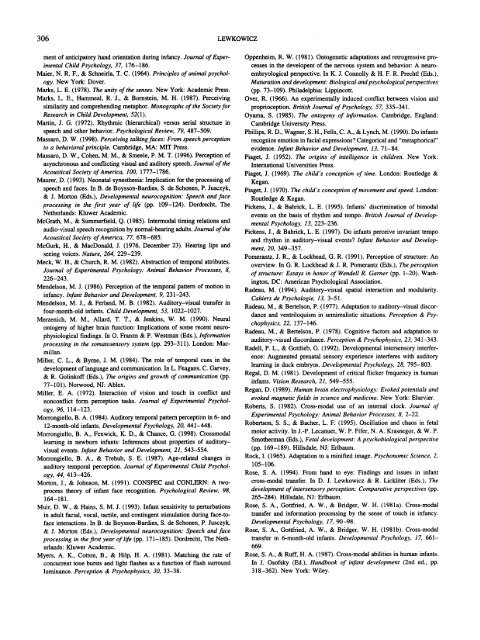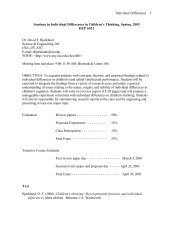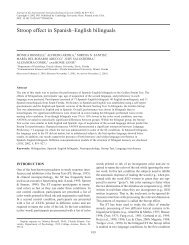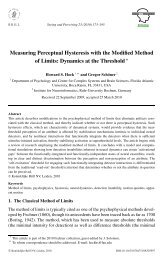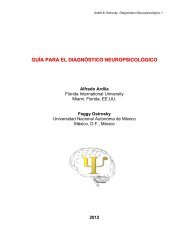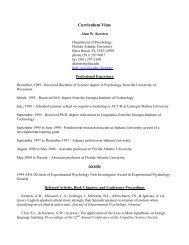The Development of Intersensory Temporal Perception: An ...
The Development of Intersensory Temporal Perception: An ...
The Development of Intersensory Temporal Perception: An ...
Create successful ePaper yourself
Turn your PDF publications into a flip-book with our unique Google optimized e-Paper software.
306 LEWKOWICZment <strong>of</strong> anticipatory hand orientation during infancy. Journal <strong>of</strong> ExperimentalChild Psychology, 37, 176-186.Maier, N. R. F., & Schneirla, T. C. (1964). Principles <strong>of</strong> animal psychology.New York: Dover.Marks, L. E. (1978). <strong>The</strong> unity <strong>of</strong> the senses. New York: Academic Press.Marks, L. E., Hammeal, R. J., & Bornstein, M. H. (1987). Perceivingsimilarity and comprehending metaphor. Monographs <strong>of</strong> the Society forResearch in Child <strong>Development</strong>, 52(1).Martin, J. G. (1972). Rhythmic (hierarchical) versus serial structure inspeech and other behavior. Psychological Review, 79, 487-509.Massaro, D. W. (1998). Perceiving talking faces: From speech perceptionto a behavioral principle. Cambridge, MA: MIT Press.Massaro, D. W., Cohen, M. M., & Smeele, P. M. T. (1996). <strong>Perception</strong> <strong>of</strong>asynchronous and conflicting visual and auditory speech. Journal <strong>of</strong> theAcoustical Society <strong>of</strong> America, 100, 1777-1786.Maurer, D. (1993). Neonatal synesthesia: Implication for the processing <strong>of</strong>speech and faces. In B. de Boysson-Bardies, S. de Schonen, P. Jusczyk,& J. Morton (Eds.), <strong>Development</strong>al neurocognition: Speech and faceprocessing in the first year <strong>of</strong> life (pp. 109-124). Dordrecht, <strong>The</strong>Netherlands: Kluwer Academic.McGrath, M., & Summerfield, Q. (1985). Intermodal timing relations andaudio-visual speech recognition by normal-heating adults. Journal <strong>of</strong> theAcoustical Society <strong>of</strong> America, 77, 678-685.MeGurk, H., & MacDonald, J. (1976, December 23). Hearing lips andseeing voices. Nature, 264, 229-239.Meek, W. H., & Church, R. M. (1982). Abstraction <strong>of</strong> temporal attributes.Journal <strong>of</strong> Experimental Psychology: <strong>An</strong>imal Behavior Processes, 8,226 -243.Mendelson, M. J. (1986). <strong>Perception</strong> <strong>of</strong> the temporal pattern <strong>of</strong> motion ininfancy. Infant Behavior and <strong>Development</strong>, 9, 231-243.Mendelson, M. J., & Fedand, M. B. (1982). Auditory-visual transfer infour-month-old infants. Child <strong>Development</strong>, 53, 1022-1027.Merzenich, M. M., AUard, T. T., & Jenkins, W. M. (1990). Neuralontogeny <strong>of</strong> higher brain function: Implications <strong>of</strong> some recent neurophysiologicalfindings. In O. Franzn & P. Westman (Eds.), Informationprocessing in the somatosensory system (pp. 293-311). London: Macmillan.Miller, C. L., & Byrne, J. M. (1984). <strong>The</strong> role <strong>of</strong> temporal cues in thedevelopment <strong>of</strong> language and communication. In L. Feagans, C. Garvey,& R. Golink<strong>of</strong>f (Eds.), <strong>The</strong> origins and growth <strong>of</strong> communication (pp.77-101). Norwood, NJ: Ablex.Miller, E. A. (1972). Interaction <strong>of</strong> vision and touch in conflict andnonconflict form perception tasks. Journal <strong>of</strong> Experimental Psychology,96, 114-123.Morrongiello, B. A. (1984). Auditory temporal pattern perception in 6- and12-month-old infants. <strong>Development</strong>al Psychology, 20, 441-448.Morrongiello, B. A., Fenwick, K. D., & Chance, G. (1998). Crossmodallearning in newborn infants: Inferences about properties <strong>of</strong> auditoryvisualevents. Infant Behavior and <strong>Development</strong>, 21, 543-554.Morrongiello, B. A., & Trehub, S. E. (1987). Age-related changes inauditory temporal perception. Journal <strong>of</strong> Experimental Child Psychology,44, 413-426.Morton, J., & Johnson, M. (1991). CONSPEC and CONLERN: A twoprocesstheory <strong>of</strong> infant face recognition. Psychological Review, 98,164-181.Muir, D. W., & Halns, S. M. J. (1993). Infant sensitivity to perturbationsin adult facial, vocal, tactile, and contingent stimulation during face-t<strong>of</strong>aceinteractions. In B. de Boysson-Bardies, S. de Schonen, P. Jusczyk,& J. Morton (Eds.), <strong>Development</strong>al neurocognition: Speech and faceprocessing in the first year <strong>of</strong> life (pp. 171-185). Dordrecht, <strong>The</strong> Netherlands:Kluwer Academic.Myers, A. K., Cotton, B., & Hilp, H. A. (1981). Matching the rate <strong>of</strong>concurrent tone bursts and light flashes as a function <strong>of</strong> flash surroundluminance. <strong>Perception</strong> & Psychophysics, 30, 33-38.Oppenheim, R. W. (1981). Ontogenetic adaptations and retrogressive processesin the developent <strong>of</strong> the nervous system and behavior: A neuroembryologicalperspective. In K. J. Connolly & H. F. R. Prechtl (Eds.),Maturation and development: Biological and psychological perspectives(pp. 73-109). Philadelphia: Lippincott.Over, R. (1966). <strong>An</strong> experimentally induced conflict between vision andproprioception. British Journal <strong>of</strong> Psychology, 57, 335-341.Oyama, S. (1985). <strong>The</strong> ontogeny <strong>of</strong> information. Cambridge, England:Cambridge University Press.Phillips, R. D., Wagner, S. H., Fells, C. A., & Lynch, M. (1990). Do infantsrecognize emotion in facial expressions? Categorical and "metaphorical"evidence. Infant Behavior and <strong>Development</strong>, 13, 71- 84.Piaget, J. (1952). <strong>The</strong> origins <strong>of</strong> intelligence in children. New York:International Universities Press.Piaget, J. (1969). <strong>The</strong> child's conception <strong>of</strong> time. London: Routledge &Kegan.Piaget, J. (1970). <strong>The</strong> child's conception <strong>of</strong> movement and speed. London:Routledge & Kegan.Pickens, J., & Bahrick, L. E. (1995). Infants' discrimination <strong>of</strong> bimodalevents on the basis <strong>of</strong> rhythm and tempo. British Journal <strong>of</strong> <strong>Development</strong>alPsychology, 13, 223-236.Piekens, J., & Bahrick, L. E. (1997). Do infants perceive invariant tempoand rhythm in auditory-visual events? Infant Behavior and <strong>Development</strong>,20, 349-357.Pomerantz, J. R., & Lockhead, G. R. (1991). <strong>Perception</strong> <strong>of</strong> structure: <strong>An</strong>overview. In G. R. Lockhead & J. R. Pomerantz (Eds.), <strong>The</strong> perception<strong>of</strong> structure: Essays in honor <strong>of</strong> Wendell R. Garner (pp. 1-20). Washington,DC: American Psychological Association.Radeau, M. (1994). Auditory-visual spatial interaction and modularity.Cahiers de Psychologie, 13, 3-51.Radeau, M., & Bertelson, P. (1977). Adaptation to auditory-visual discordanceand ventriloquism in semirealistic situations. <strong>Perception</strong> & Psychophysics,22, 137-146.Radeau, M., & Bertelson, P. (1978). Cognitive factors and adaptation toauditory-visual discordance. <strong>Perception</strong> & Psychophysics, 23, 341-343.Radell, P. L., & Gottlieb, G. (1992). <strong>Development</strong>al intersensory interference:Augmented prenatal sensory experience interferes with auditorylearning in duck embryos. <strong>Development</strong>al Psychology, 28, 795-803.Regal, D. M. (1981). <strong>Development</strong> <strong>of</strong> critical flicker frequency in humaninfants. Vision Research~ 21, 549-555.Regan, D. (1989). Human brain electrophysiology: Evoked potentials andevoked magnetic fields in science and medicine. New York: Elsevier.Roberts, S. (1982). Cross-modal use <strong>of</strong> an internal clock. Journal <strong>of</strong>Experimental Psychology: <strong>An</strong>imal Behavior Processes, 8, 2-22.Robertson, S. S., & Bacher, L. F. (1995). Oscillation and chaos in fetalmotor activity. In J.-P. Lecanuet, W. P. Fifer, N. A. Krasnegor, & W. P.Smotherman (Eds.), Fetal development: A psychobiological perspective(pp. 169-189). Hillsdale, NJ: Erlbaum.Rock, I. (1965). Adaptation to a minified image. Psychonomic Science, 2,105-106.Rose, S. A. (1994). From hand to eye: Findings and issues in infantcross-modal transfer. In D. J. Lewkowicz & R. Lickliter (Eds.), <strong>The</strong>development <strong>of</strong> intersensory perception: Comparative perspectives (pp.265-284). Hillsdale, NJ: Erlbaum.Rose, S. A., Gotffried, A. W., & Bridger, W. H. (1981a). Cross-modaltransfer and information processing by the sense <strong>of</strong> touch in infancy.<strong>Development</strong>al Psychology, 17, 90-98.Rose, S. A., Gottfried, A. W., & Bridger, W. H. (1981b). Cross-modaltransfer in 6-month-old infants. <strong>Development</strong>al Psychology, 17, 661-669.Rose, S. A., & Ruff, H. A. (1987). Cross-modal abilities in human infants.In J. Os<strong>of</strong>sky (Ed.), Handbook <strong>of</strong> infant development (2nd ed., pp.318-362). New York: Wiley.


